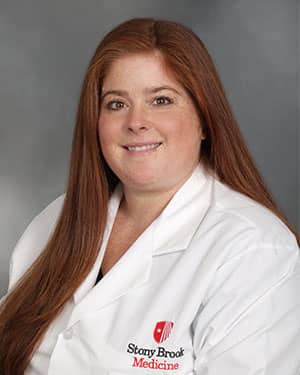Navigation Pediatric Endocrinology
Pediatric Endocrinology
Stony Brook Children's Pediatric Endocrinology Division has a wide range of expertise in diagnosing and treating endocrine disorders.
A clinical resource for all of Suffolk County, we are also a designated endocrinology referral site for the State of New York's Newborn Screening Program. The division treats newborns to young adults in both inpatient and outpatient settings.
Our child- and family-focused care is multidisciplinary, with the advanced practices characteristic of an academic medical center. We train tomorrow's specialists and engage in significant research.
Services
The division of Pediatric Endocrinology consists of four board-certified pediatric endocrinologists, a certified diabetes educator, a nutritionist who is also a certified diabetes educator, and two administrative assistants. We provide a team approach to optimize the ongoing care, training and education that patients and their families need to manage their condition.
Patients referred for an endocrine evaluation are thoroughly evaluated by one of our endocrinologists on either an inpatient or outpatient basis. For this purpose, past records including growth charts, prior pertinent laboratory tests, evaluations, and treatments are critical and should be brought to the appointment.
We are a Diabetes Center of Excellence that provides in-office hemoglobin A1c testing and the latest technological advances in diabetes care.
Conditions we commonly deal with include:
- Adrenal disorders
- Calcium, phosphorus, and bone disorders
- Diabetes
- Endocrine forms of Hypertension
- Gender identity disorders
- Growth disorders
- Hirsutism
- Hypoglycemia
- Lipid disorders
- Metabolic syndrome
- Obesity
- Pubertal and reproductive system disorders
- Sexual differentiation conditions
- Thyroid disorders
Our Team
The core of our team consists of four board-certified endocrinologists. A pediatric nutritionist also plays a key role in supporting our team. Additionally, our patients have access to social services professionals.
Locations
Center Moriches Advanced Pediatric Care
600 Main Street, Suite ACenter Moriches, NY 11934
(631) 444-KIDS (5437)
Fax: (631) 878-8083
Commack Advanced Pediatric Care
500 Commack Road, Suite 104Commack, NY 11725
(631) 444-KIDS (5437)
Fax: (631) 638-0157
East Islip Advanced Pediatric Care
269 East Main StreetEast Islip, NY 11730
(631) 444-KIDS (5437)
Fax: (631) 581-9561
Lake Grove Advanced Pediatric Care
4 Smith Haven Mall, Suite 101Lake Grove, NY 11755
(631) 444-KIDS (5437)
Fax: (631) 444-4990
Research and Education
The Division of Pediatric Endocrinology currently participates in clinical research.
For information on faculty publications, click below:
Advances and Recognitions
New York State Newborn Screening Referral Site
Stony Brook is a designated referral center for the New York State Newborn Screening Program, which screens every newborn shortly after birth with a tiny blood sample taken from the heel. Long Island newborns with thyroid or adrenal disorders are referred to us to confirm the diagnosis and provide treatment.
Definitions
Located above each kidney, these glands make cortisol, androgens and aldosterone, hormones that regulate sodium (salt) balance, blood sugar, blood pressure and play a role in sexual development during puberty.
Hypocalcemia (low serum calcium concentration) and hypercalcemia (high serum calcium concentration), as well as disorders resulting in defective mineralization of bone in children, including various types of rickets.
Diabetes mellitus is a disease that causes problems with the body’s ability to make and use insulin, an important hormone that transports glucose (sugar) out of the bloodstream and into cells waiting to use the glucose for energy. Diabetes is a chronic disorder of the metabolism. For pediatric diabetics and their families, a diagnosis of diabetes means there will be careful monitoring of these factors: blood sugar and insulin levels, nutrition, physical activity and response to emotional stress.
A physician who specializes in the function of the endocrine system and treatment of its disorders.
Conditions in which children and adolescents feel they belong to a different gender.
Lower than normal blood sugar levels.
Abnormal levels of triglycerides or cholesterol in the blood.
A combination of risk factors that increase the risk of heart disease and diabetes.
Includes children with abnormal genital development or sexual differentiation.
Disorders when the thyroid gland is overactive or underactive or when the thyroid gland is enlarged (goiter), including thyroid nodules.



